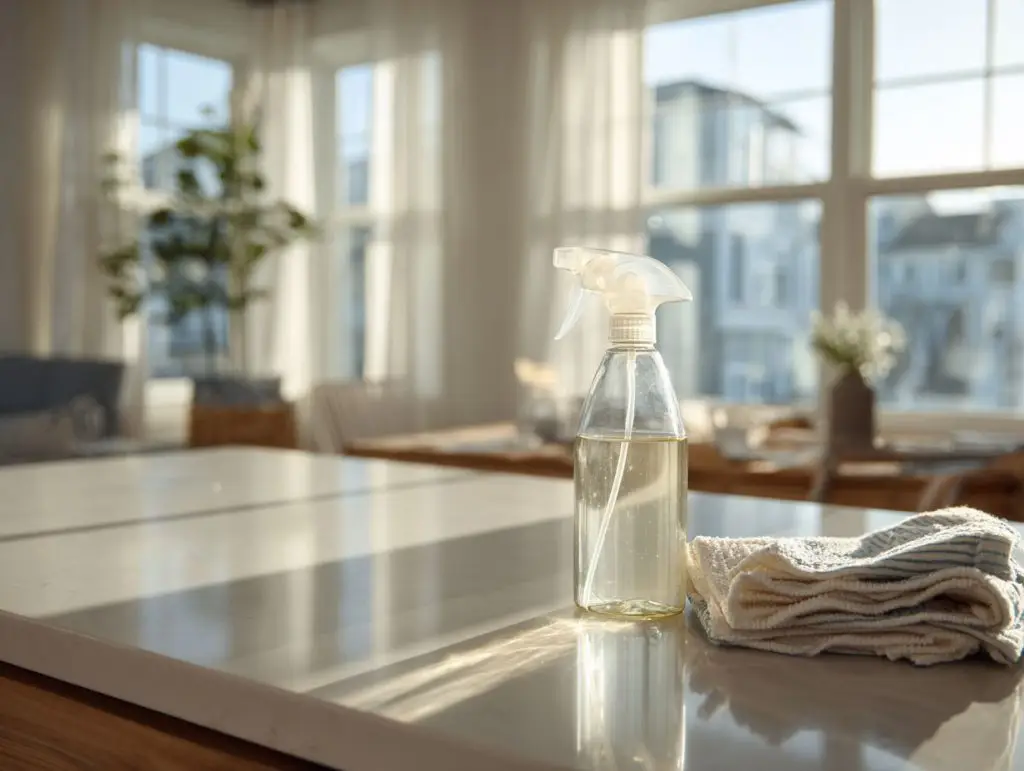
The Routine I Trusted
For years, my cleaning shelf looked like everyone else’s in Destin: a mix of bright bottles, citrus scents, and promises like “99.9% germ-free.” I used them without thinking — sprayed the counters, wiped the floors, added a bit extra for “good measure.”
The smell of lemon meant clean, right?
That’s what I believed.
It wasn’t until one summer afternoon, while restocking supplies, that I actually stopped to read the labels. The fine print was a shock — not because of what I understood, but because of what I didn’t. Words like “isopropanol,” “benzalkonium chloride,” “ethylene glycol,” and long warnings about ventilation made me realize how little I knew about what I was spraying around every day.
When “Fresh” Isn’t Always Safe
In Destin, we keep our windows closed for most of the year — humidity, heat, air conditioning. That means everything I sprayed stayed in the air much longer than I thought.
The “clean” smell that lingered after mopping wasn’t freshness — it was residue.
After a few months of regular use, I started noticing headaches after cleaning days, my hands were constantly dry, and my dog began sneezing when I used strong disinfectants near the floor. None of it felt dangerous, just annoying — until I realized these were all signs of chemical overload in a poorly ventilated home.
The Moment I Realized Something Was Off
One morning, while wiping the kitchen counters, I caught myself holding my breath. Not intentionally — it just became a reflex. That’s when it hit me: if I have to hold my breath to make something “clean,” it probably isn’t the right way to do it.
I started comparing the products I used with what professional cleaning teams in Destin actually brought to homes. The difference was striking. Sharky’s bottles had no synthetic fragrance, no bright colors, no marketing slogans — just labels with clear ingredient lists and dilution ratios.
That’s when I understood: professional cleaning isn’t just about making things shine; it’s about making them safe to live around.
What I Planned to Change
I made a decision that week — to review every product in my house and rebuild my cleaning routine from scratch.
If I didn’t know exactly what was in a bottle or how it interacted with the air, fabrics, or pets, it wasn’t staying.
Understanding What “Safe” Really Means
When I first began replacing my products, I learned that “eco,” “natural,” or “non-toxic” doesn’t always mean safe or effective. Some “green” cleaners simply mask strong chemicals with essential oils, while others fail to disinfect at all. What matters most is balance — ingredients that clean well and break down safely in air and water.
Professionals at Sharky use products that are pH-balanced, fragrance-free, and made for ventilation-controlled homes like ours in Destin. They focus on performance and safety, not perfume.
Step 1: Checking the Ingredients
I went through my entire cleaning cabinet and searched every label. These were my new rules:
- No artificial fragrance or dyes.
These add nothing to cleaning power but can trigger allergies, headaches, and skin irritation. - Avoid ammonia and chlorine mixtures.
Many multipurpose sprays combine incompatible ingredients that release fumes when mixed. - No glycol ethers or quaternary ammonium compounds (look for “quats” or “benzalkonium chloride”). They stay on surfaces and linger in indoor air for days.
- Short ingredient lists.
If the label looked like a chemistry textbook, it didn’t belong in my house.
I replaced them with biodegradable, non-scented solutions — mostly concentrated surfactant-based cleaners and mild acid or alkaline formulas designed for specific surfaces.
Step 2: Ventilation and Dilution
Most people in Destin underestimate how much air matters during cleaning. Our homes are built to stay cool, not breezy, so any strong chemical quickly becomes part of the air we breathe.
I began opening windows before cleaning, running fans, and — most importantly — diluting everything properly.
Professional cleaners never use full-strength formulas unless required for deep disinfection. Overconcentration doesn’t clean better; it just leaves residue that attracts more dirt.
Step 3: Matching Products to Surfaces
Instead of using one “all-purpose” cleaner everywhere, I learned to select based on material:
- Glass and mirrors: low-alcohol solutions to prevent streaking and indoor fumes.
- Wood and furniture: neutral pH, no silicone or wax — those coatings trap dust.
- Kitchen surfaces: mild degreasers, fragrance-free, safe around food.
- Floors: low-foam detergents designed for rinsing without film.
- Bathrooms: citric acid–based cleaners instead of chlorine bleach — same results, less irritation.
The shift didn’t just make my cleaning safer; it also made surfaces stay cleaner longer, because there was no sticky residue left behind.
Step 4: Protecting Skin and Indoor Air
I started wearing lightweight cleaning gloves and using refillable spray bottles to avoid aerosolized particles.
I also replaced synthetic air fresheners with natural ventilation — a bowl of baking soda in problem areas and a simple linen spray made with distilled water and a drop of pure lemon oil. The air felt fresher, not perfumed.
Step 5: Building a Smarter Cleaning System
The biggest lesson I learned from Sharky’s team is that safety isn’t a trend — it’s a system.
They use measured amounts, label every bottle, store chemicals separately, and never mix brands or formulas. That discipline prevents nearly all household cleaning hazards.
Now, my cleaning shelf looks boring — plain bottles, handwritten labels, no color. But the air is lighter, the surfaces stay brighter, and my dog doesn’t sneeze anymore.
What Changed
After switching to safe, properly used products, my home in Destin finally feels as clean as it looks. The difference isn’t dramatic — it’s subtle but lasting: no heavy scent, no irritation, no film on the counters.
That’s the real definition of “clean.”
And once you experience it, there’s no going back.
Read also: Why My House Never Looked Clean — Until I Changed How I Cleaned It


